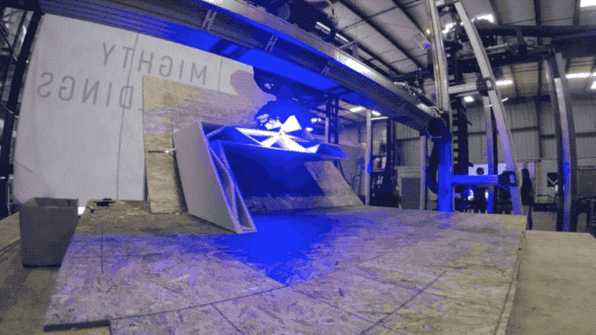Mighty Buildings has just added another $22 million to its Series B funding round, during which it had already raised $40 million. In total, the Oakland, California startup has collected $100 million since it was founded in 2017. This will allow the company to continue to drive additive construction, a new, but quickly growing industry segment.
Mighty Buildings is an innovative firm in the construction 3D printing space, not only because it has already begun numerous projects and partnered with housing development firms to quickly deploy the technology, but because its technology is unique. Unlike every other cement printing company, Mighty Buildings does not simply extrude a quick-drying form of concrete on-site. Instead, it uses a proprietary material that includes a photopolymer resin that is cured during the printing process to produce composite elements that are shipped to the building site, where they are assembled.

The Mighty Buildings construction process, featuring UV curing for the polymer portion of the mixture. Image courtesy of Mighty Buildings.
With this process, the startup claims that it can 3D print homes “two times as quickly with 95% less labor hours and 10-times less waste” in comparison to traditional construction techniques. Mighty Buildings says that it can 3D print a 350-square-foot studio apartment in just a day.
“As a founding team, we have long been passionate about solving productivity for construction in a sustainable way,” said co-founder and CEO Slava Solonitsyn. “We have spent four years figuring out what it takes to achieve that. We believe that we have a master plan now that can work.”
So far, Mighty Buildings has 3D printed numerous accessory dwelling units (ADUs), but the company aims to use its investment to initiate the construction of multistory buildings, beginning with two-to-three-story single family homes and townhouses. This the startup hopes will result in its first prototype multistory building in late 2022 or early 2023, according to Ruben.
“Along with the sustainability improvements already captured by our new formula, this will allow us to develop our next-generation material to get us even closer to our goal of being carbon neutral by 2028,” said Sam Ruben, co-founder and chief sustainability officer of Mighty Buildings. “It will also give us opportunities to implement improvements in our existing design by reducing the impact of our foundations and other, nonprinted elements.”
With the extra funds, the firm believes it will be able to enhance its supply chain and speed up its research and development, including achieving “net-zero” carbon emissions by 2028. While this would be about 22 years ahead of the larger construction industry, according to Mighty Buildings, the concept of net zero emissions is always a problematic one. Typically stated as a vague goal, net zero emissions means that the amount of greenhouse gasses put out are cancelled out in one way or another, most often through carbon offsets or by future plans to rely on non-existent technologies, like carbon capture.
To achieve net-zero emissions, Mighty Buildings has said that it will establish micro factories that are “high-throughput, sustainable”, speed up “blue skies” research, develop composites featuring recycled or bio-based materials, and create partnerships in the supply chain. Exactly what the micro factories look like and how they contribute to reduced emissions hasn’t been specified, but the company has said that they will be able to produce 200 to 300 homes annually. These factories would be built where gaps in housing currently exist.
From a degrowth perspective, the most sustainable method for achieving zero emissions and affordable housing simultaneously would be to repurpose existing, unused buildings and decommodify the housing industry. Nevertheless, Mighty Buildings is forward-thinking for the construction industry, already catching onto the modular, prefab trend that seems necessary for bringing repeatability and predictability to the sector. Given the huge impact of the industry on the ecosystem, any improvements it can bring to sustainable production could have an important impact on its carbon footprint.
As a small firm in an emerging segment within a huge market, it is already showing promise from a financial standpoint. The company claims that it has over $7. Million in total contracted revenue in Q2 of 2021.
Subscribe to Our Email Newsletter
Stay up-to-date on all the latest news from the 3D printing industry and receive information and offers from third party vendors.
You May Also Like
3D Printing Unpeeled: Biofuel Waste to Filament & Sustainable Photopolymers
I can’t ever remember a day with so many potentially high impact news stories have come out. In one story, we all know that there are problems with the safety...
Finnair Hires AM Craft to 3D Print Plastic Parts for Aircraft Interiors
Riga-based AM Craft, a supplier specialized in 3D printing aviation components and certified under EASA Part 21G, announced a significant achievement today. The company will assist in upgrading Finnair’s A320...
3DPOD Episode 198: High Speed Sintering with Neil Hopkinson, VP of AM at Stratasys
Neil Hopkinson, a pioneering 3D printing researcher, played a pivotal role in developing a body of research that is widely utilized today. He also invented High Speed Sintering (HSS), also...
3D Printing Webinar and Event Roundup: May 12, 2024
Webinars and events are picking up in the AM industry this week! ASTM International continues its Professional Certificate Course and Stratasys continues its advanced in-person trainings, while 3D Systems is...

































